The AMD Ryzen 9 3950X Review: 16 Cores on 7nm with PCIe 4.0
by Dr. Ian Cutress on November 14, 2019 9:00 AM ESTCPU Performance: Rendering Tests
Rendering is often a key target for processor workloads, lending itself to a professional environment. It comes in different formats as well, from 3D rendering through rasterization, such as games, or by ray tracing, and invokes the ability of the software to manage meshes, textures, collisions, aliasing, physics (in animations), and discarding unnecessary work. Most renderers offer CPU code paths, while a few use GPUs and select environments use FPGAs or dedicated ASICs. For big studios however, CPUs are still the hardware of choice.
All of our benchmark results can also be found in our benchmark engine, Bench.
Corona 1.3: Performance Render
An advanced performance based renderer for software such as 3ds Max and Cinema 4D, the Corona benchmark renders a generated scene as a standard under its 1.3 software version. Normally the GUI implementation of the benchmark shows the scene being built, and allows the user to upload the result as a ‘time to complete’.
We got in contact with the developer who gave us a command line version of the benchmark that does a direct output of results. Rather than reporting time, we report the average number of rays per second across six runs, as the performance scaling of a result per unit time is typically visually easier to understand.
The Corona benchmark website can be found at https://corona-renderer.com/benchmark
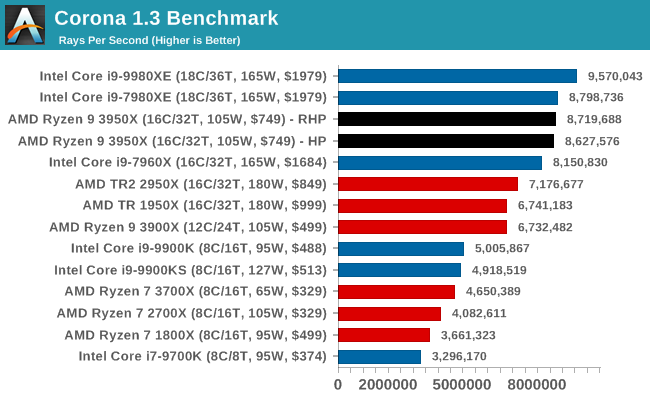
Intel's HEDT chips are quite good at Corona, but if we compare the 3900X to the 3950X, we still see some good scaling.
Blender 2.79b: 3D Creation Suite
A high profile rendering tool, Blender is open-source allowing for massive amounts of configurability, and is used by a number of high-profile animation studios worldwide. The organization recently released a Blender benchmark package, a couple of weeks after we had narrowed our Blender test for our new suite, however their test can take over an hour. For our results, we run one of the sub-tests in that suite through the command line - a standard ‘bmw27’ scene in CPU only mode, and measure the time to complete the render.
Blender can be downloaded at https://www.blender.org/download/
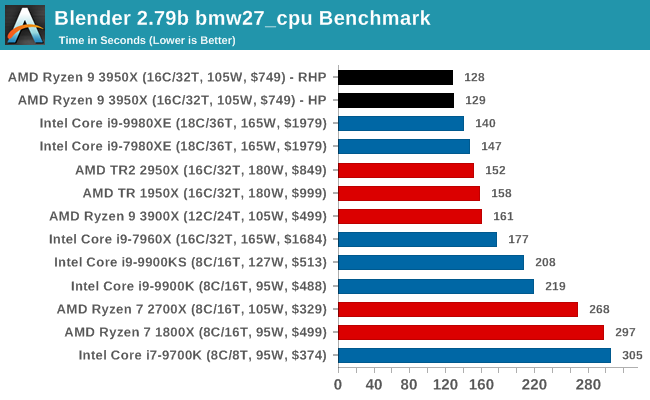
AMD is taking the lead in our blender test, with the 16-core chips easily going through Intel's latest 18-core hardware.
LuxMark v3.1: LuxRender via Different Code Paths
As stated at the top, there are many different ways to process rendering data: CPU, GPU, Accelerator, and others. On top of that, there are many frameworks and APIs in which to program, depending on how the software will be used. LuxMark, a benchmark developed using the LuxRender engine, offers several different scenes and APIs.
In our test, we run the simple ‘Ball’ scene on both the C++ code path, in CPU mode. This scene starts with a rough render and slowly improves the quality over two minutes, giving a final result in what is essentially an average ‘kilorays per second’.
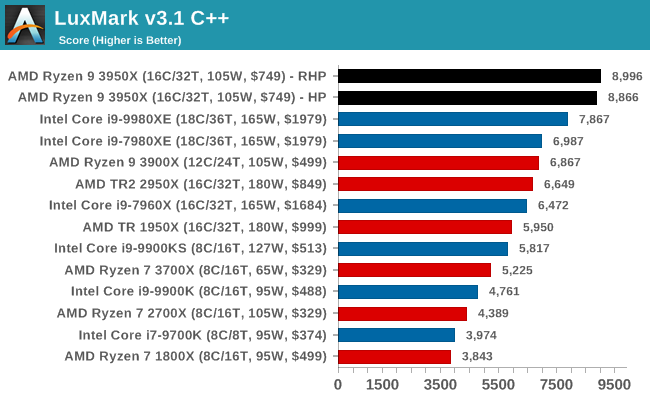
Despite using Intel's Embree engine, again AMD's 16-cores easily win out against Intel's 18-core chips, at under half the cost.
POV-Ray 3.7.1: Ray Tracing
The Persistence of Vision ray tracing engine is another well-known benchmarking tool, which was in a state of relative hibernation until AMD released its Zen processors, to which suddenly both Intel and AMD were submitting code to the main branch of the open source project. For our test, we use the built-in benchmark for all-cores, called from the command line.
POV-Ray can be downloaded from http://www.povray.org/
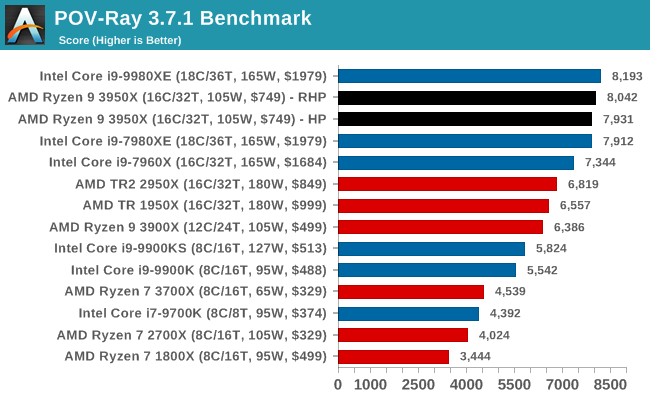
POV-Ray ends up with AMD 16-core splitting the two Intel 18-core parts, which means we're likely to see the Intel Core i9-10980XE at the top here. It would have been interesting to see where an Intel 16-core Core-X on Cascade would end up for a direct comparison, but Intel has no new 16-core chip planned.


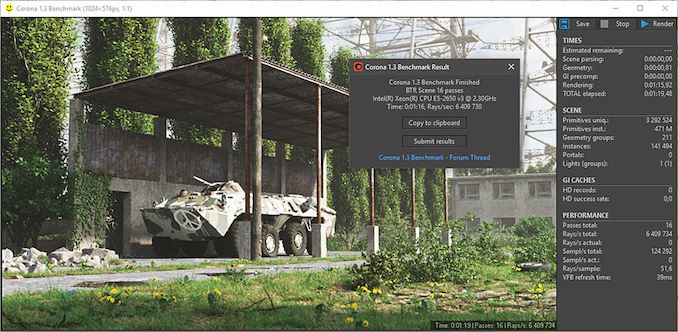








206 Comments
View All Comments
Ryan Smith - Thursday, November 14, 2019 - link
Fixed. Thanks!Manabu - Thursday, November 14, 2019 - link
Why is the Ryzen 3700X is missing from so many charts through the article, including the final 2019 performance vs price chart? And it's already about time to have tested the 3600 too.Ian Cutress - Thursday, November 14, 2019 - link
Gavin tested the chips for the 3900X/3700X review. I've done this review with updated OS. Plus I've been moving house, and everything is still in boxes.Adonisds - Thursday, November 14, 2019 - link
Is the 4.7 GHz boost fake news?Total Meltdowner - Thursday, November 14, 2019 - link
AMD is like Trump here, telling the truth.III-V - Thursday, November 14, 2019 - link
Unlike Trump though, the truth doesn't even matter here. Performance is all that matters, not a completely irrelevant numberIan Cutress - Thursday, November 14, 2019 - link
There's a page that covers it.Irata - Thursday, November 14, 2019 - link
Just checked two other reviews (so far)- Hexus reached 4,665.54 Mhz
and bit-tech stated "With a 4.7GHz boost, which we actually saw regularly, it wasn't surprising to see the Ryzen 9 3950X top the Cinebench single-threaded test,"
Total Meltdowner - Thursday, November 14, 2019 - link
Baller CPUneogodless - Thursday, November 14, 2019 - link
Is the Intel 9980XE pricing correct in the 2019 CPU Performance chart? It appears on Intel's web site to be $1979-1999, and the cheapest I found it online was on sale at Amazon for $1949.